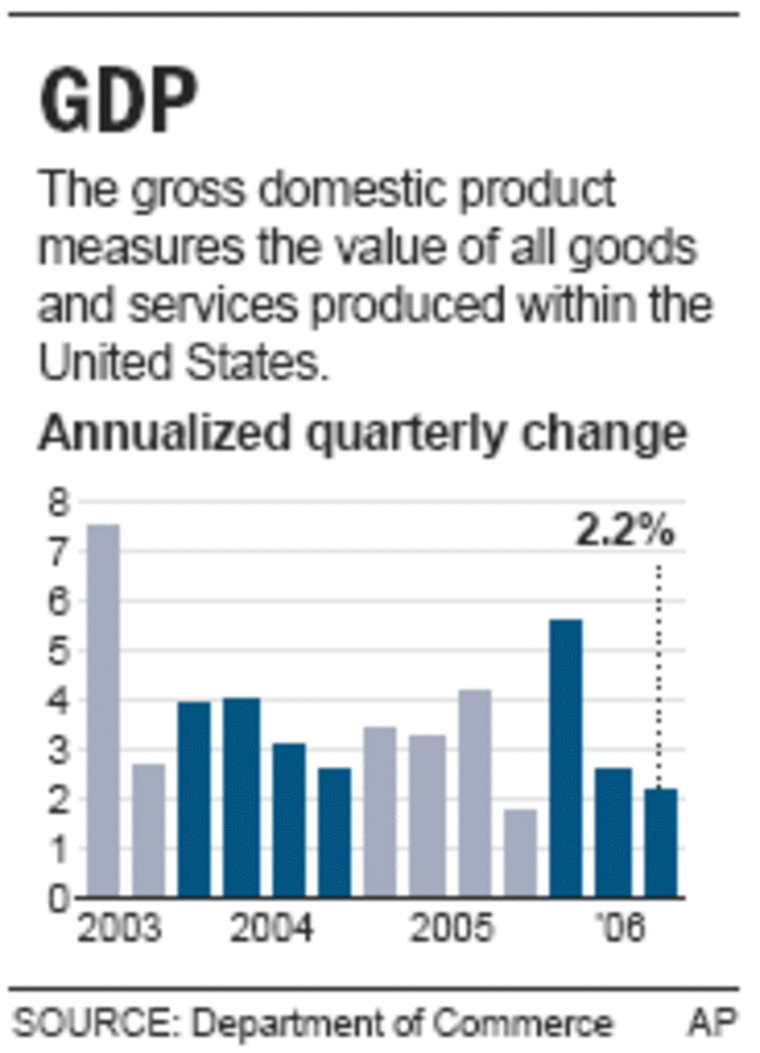The once-bustling economy has turned somewhat lethargic but should show enough energy to extend the long-running expansion and avoid slipping into a recession.
That is the feeling, for now, among economists as they digested the latest batch of economic news.
The economy lost steam in the late summer but not nearly as much as first thought, a hopeful sign the country is weathering the housing slump.
The Commerce Department reported Wednesday that economic growth clocked in at a 2.2 percent annual rate in the July-to-September quarter.
The new reading was a considerable upgrade from the government’s earlier estimate of a 1.6 percent growth rate, which would have been the worst showing in more than three years if it had held up.

The main factors for the higher estimate were stronger inventories amassed by companies and a trade deficit that didn’t strain economic growth as much.
The improvement, however, could not hide the fact that the economy has been losing momentum all year.
Over the first three months of the year, the economy grew at a blistering pace — 5.6 percent, the best performance in 2 1/2 years. From April through June, the growth rate was 2.6 percent as consumers and companies tightened spending in response to surging energy prices.
The further slowdown in late summer mostly reflected the deepening housing slump. Investment in home building was reduced by the largest amount in 15 years.
“It was a tough quarter, but not as tough as previously estimated,” said Mark Zandi, chief economist at Moody’s Economy.com. “But there’s reason to be optimistic that the expansion will remain intact. With businesses so flush with profits, they will continue to invest and hire and the economy will continue to move forward,” he predicted.
Wall Street was cheered by the news on the economy. The Dow Jones industrials jumped 90.28 points to close at 12,226.73.
On another encouraging note, a Federal Reserve survey released Wednesday found that most parts of the country had moderate economic growth in the late fall despite troubles in the housing market and the automotive industry.
Fresh evidence of the ailing housing market came from a separate Commerce Department report that showed new-home sales fell in October by 3.2 percent, the most in three months, although home prices did rise.
“So far the housing correction has been orderly and it does not appear to have done significant damage to consumers or to the economy but the situation bears continued watching,” said Carl Tannenbaum, chief economist at LaSalle Bank.
The Bush administration insists the economy is fundamentally sound. But Democrats say that the poor and the middle class have benefited little from the economic expansion over the past five years.
Democrats who will take over the House and Senate in January want to raise the federal minimum wage, among their other priorities.
Consumers and businesses did their part keeping the economy moving in the third quarter.
Consumers spending rose at a 2.9 percent pace, the most since the first months of this year.
Businesses stepped up investment in equipment and software at 7.2 percent pace — also the best showing since the first quarter. Also, their investment increased in new plants, office buildings and other commercial construction.
Companies’ profits gained ground in the third quarter. One measure showed after-tax profits rising by 4.6 percent, compared with 0.3 percent in the second quarter.
All that helped to cushion against the housing slump. Builders cut spending on home building at a 18 percent annual rate, even deeper than the government estimated a month ago and the most since early 1991. That sliced 1.16 percentage points off the gross domestic product in the third-quarter, the most in nearly 25 years.
GDP measures the value of all goods and services produced within the United States and is considered the best barometer of economic standing.
The revised GDP figure for the third quarter was better than the 1.8 percent pace that economists had forecast. Nevertheless, it was the lowest rate since the end of 2005, when the economy was reeling from the blows of the Gulf Coast hurricanes.
Even with the slowdown, most economists do not believe the economy is in danger of tipping into recession. But they do think the economy is in for some lethargic times.
Many economists believe the economy will grow at a 2.5 percent pace or less from October through December.
The latest batch of economic news came one day after Federal Reserve Chairman Ben Bernanke said the economy should be able to weather the strains of the housing slump and weakness in the auto sector.
The Fed has left interest rates alone since August and is expected to again stay on the sidelines at its last meeting of this year, on Dec. 12. The Fed’s pause came after it had consistently raised rates for more than two years to fend off inflation.
The Fed’s goal is to slow the economy sufficiently to thwart inflation but not so much that it slides into recession.
An inflation gauge tied to the GDP report showed that core prices — excluding food and energy — advanced at a rate of 2.2 percent in the third quarter. That was an improvement from the 2.7 percent pace in the second quarter. Energy prices, which had soared in the summer, have since settled down.